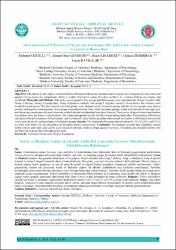Determination of the efficacy of thymol, eucalyptus and oxalic acid in the control of varroosis in honey bees

Göster/
Erişim
info:eu-repo/semantics/openAccesshttp://creativecommons.org/licenses/by-nc/3.0/us/Tarih
2024Üst veri
Tüm öğe kaydını gösterÖzet
Objective: The subject of our study is to determine the efficacies of the natural products such as thyme oil, eucalyptus oil, and oxalic acid
against Varroa destructor ectoparasite, which is widely observed in honey bee (Apis mellifera L.) colonies both in our country and
worldwide Materials and Methods: The study was designed as five groups and these groups were separated into Group 1 (oxalic acid),
Group 2 (thyme), Group 3 (eucalyptus), Group 4 (positive control), and Group 5 (negative control). Seven honey bee colonies were
included in each group. The first, second, and third groups were designed as the treatment groups and the last two groups were kept as
positive and negative control groups. Each group consisted of seven hives. In the treatment groups; oxalic acid was dissolved in glycerin,
and thyme and eucalyptus oils were dissolved in ethyl alcohol and absorbed into special towels. Two pieces of special towels per beehive
were placed on to the frames in the beehives. The treatments applied weekly for three weeks during September. The treatment efficiencies
calculated with the Henderson-Tilton formula and the General Linear Model procedure determined the statistical differences between the
oxalic acid, thyme oil, and eucalyptus oil treatment groups. Results: The treatment efficiencies determined as 91.74%, 82.25%, and 79.2%
in oxalic acid, thyme oil, and eucalyptus oil treatment groups, respectively. Conclusion: The findings revealed that completely natural
herbal extracts and oxalic acid can be used instead of synthetic chemical drugs against Varroosis. Toxication and unnatural deaths were
not observed in honey bees throughout the trials. Amaç: Çalışmamızın amacı, bal arısı (Apis mellifera L.) kolonilerinde hem ülkemizde, hem de Dünyada yaygın olarak gözlemlenen
Varroa destructor ektoparazitine karşı doğal ürünler olan timol ve ökaliptus yağları ile okzalik asidin etkinliklerini belirlemektir. Gereç
ve Yöntem: Çalışma, beş gruptan oluşmuştur ve bu gruplar; Grup 1 (okzalik asit), Grup 2 (kekik), Grup 3 (okaliptus), Grup 4 (pozitif
kontrol) ve Grup 5 (negatif kontrol) olarak isimlendirilmiştir. Her gruba, yedi adet bal arısı kolonisi dâhil edilmiştir. Birinci, ikinci ve
üçüncü gruplar tedavi gruplarını ve son iki grup da pozitif ve negatif kontrol gruplarını oluşturacak şekilde tasarlanmıştır. Tedavi
gruplarında; okzalik asit gliserinde, kekik ve ökaliptus yağları etil alkolde çözdürülerek özel havlulara emdirilmiştir. Havlular,
kovanlardaki çerçevelerin üzerine konulmuş ve her kovana ikişer adet yerleştirilmiştir. Tedaviler, Eylül ayında haftada bir olmak üzere,
toplamda üç kez uygulanmıştır. Tedavi etkinlikleri ise Henderson-Tilton formülü ile hesaplanmış olup okzalik asit, kekik ve ökaliptus
yağları tedavi grupları arasındaki istatistiksel fark, Genel Lineer Model prosedürü ile tespit edilmiştir. Bulgular: Tedavi etkinlikleri;
okzalik asit, kekik ve ökaliptus yağları tedavi gruplarında sırasıyla %91.74 %82.25 ve %79.2 olarak tespit edilmiştir. Sonuç: Elde edilen
bulgular, Varroosis’e karşı sentetik kimyasal ilaçlar yerine, tamamen doğal bitkisel ekstraktların ve okzalik asitin kullanılabileceğini
ortaya koymuştur. Saha denemeleri boyunca, bal arılarında toksikasyon belirtileri ya da doğal olmayan ölümler gözlenmemiştir.
Kaynak
Balıkesir Sağlık Bilimleri Dergisi (BSBD)Cilt
13Sayı
1Koleksiyonlar
Aşağıdaki lisans dosyası bu öğe ile ilişkilidir:


















